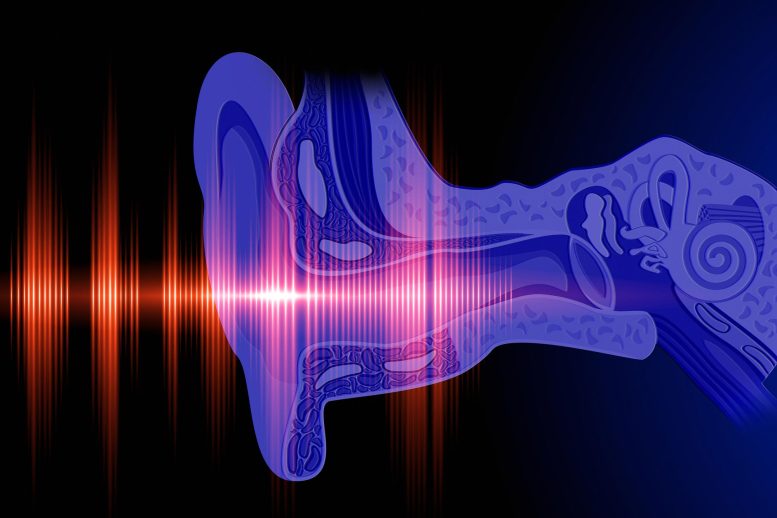
Posted on 03/17/2025 5:43:20 AM PDT by Red Badger

A new study suggests that the brain helps regulate the ear’s sensitivity to sound by sending signals to the cochlea, potentially leading to treatments for conditions like tinnitus and hyperacusis. Using advanced imaging technology, researchers observed real-time cochlear activity in awake mice, revealing how the brain compensates for hearing loss. Researchers from the Keck School of Medicine of USC, in partnership with Baylor College of Medicine in Houston, Texas, utilized a cutting-edge imaging tool to study the mouse inner ear, leading to a discovery that may aid in the treatment of hearing disorders.
A recent study published in the Journal of Neuroscience suggests that the brain may help regulate the ear’s sensitivity to sound and compensate for hearing loss by sending signals to the cochlea, a structure in the inner ear. This discovery could pave the way for new treatments for challenging hearing disorders such as hyperacusis, where everyday sounds become uncomfortably loud, and tinnitus, a condition characterized by ringing, buzzing, or other phantom sounds in the absence of an external source.
The study was made possible by a groundbreaking imaging tool that enabled researchers to capture real-time images of the cochlea in awake animals for the first time.
The cochlea uses sensory hair cells to detect sound waves in the air, then converts them into electrical signals that the brain can process. Most cochlear nerves carry information from the cochlea to the brain, but about 5% send signals in the opposite direction: from the brain to the cochlea. The exact role of those fibers has been a mystery, because researchers have struggled to measure cochlear activity in humans or animals while they are awake.
To change that, researchers from the Keck School of Medicine of USC, in collaboration with Baylor College of Medicine in Houston, Texas, have developed a new way to look at activity in the inner ear by adapting an imaging technique called optical coherence tomography (OCT), which is widely used in ophthalmology offices to scan the retina for conditions like glaucoma and macular degeneration. OCT uses light waves to scan tissue and create a 3D image, similar to the way ultrasound creates images from sound waves. Using this approach, the researchers captured real-time images of the cochlea in action.
“OCT lets us look down the ear canal, through the eardrum and bone into the cochlea, and measure how it’s working—noninvasively and without pain,” said John Oghalai, MD, professor and chair of otolaryngology-head and neck surgery and the Leon J. Tiber and David S. Alpert Chair in Medicine at the Keck School of Medicine. “What’s exciting about this is it lets us study how the brain is controlling the cochlea in real time.”
Using this tool, Oghalai and his team, including co-leaders Patricia Quiñones, research associate in Oghalai’s Lab, Brian E. Applegate, professor of otolaryngology-head and neck surgery at the Keck School of Medicine, and Matthew J. McGinley, assistant professor at Baylor College of Medicine, found that in healthy mice, cochlear activity does not change over the short term. But in mice with genetic hearing loss, cochlear function increased, indicating that the brain was enhancing the cochlea’s sensitivity as a response to long-term hearing loss.
Measuring cochlear function
A leading theory about the nerves that send signals from the brain to the cochlea (known as “efferent” fibers) is that they control the cochlea’s response to sound on a short-term basis, similar to the way our pupils work. Bright light makes the pupils constrict, while stress causes them to dilate. Could the cochlea be acting in a similar way?
To explore whether the cochlea responds to short-term stimuli, the researchers measured cochlear activity in mice using OCT. At the same time, they tracked the shifting brain states of the mice by measuring changes in pupil size. As brain states changed, cochlear activity stayed the same, suggesting that the inner ear does not modulate hearing on a short-term basis.
Next, the researchers genetically altered mice to disable the nerves carrying information from the inner ear to the brain (“afferent” fibers), causing hearing loss. Using OCT, they found that the cochlea was working overtime to compensate.
“As humans age and our hair cells die off, we start to lose our hearing. These findings suggest that the brain can send signals to the remaining hair cells, essentially telling them to turn up the volume,” said Oghalai, who is also a professor of biomedical engineering at the USC Viterbi School of Engineering.
The next step is a clinical trial to test drugs that block efferent fibers, which could lower the volume for patients with hyperacusis and may also help address tinnitus.
Improving diagnosis
OCT also holds promise for improving the diagnosis and treatment of hearing disorders. Now that Oghalai’s team has adapted OCT for cochlear imaging in awake mice, they are testing a version of the tool for patients in a new NIH-funded study.
The technology could ultimately allow providers to diagnose hearing problems based on physiology, not just performance on a hearing exam, and to tailor treatments to individual needs.
“This is the first step toward a tool that lets us look into a patient’s ear, find out what the problem is and treat it,” Oghalai said.
Reference:
“The medial olivocochlear efferent pathway potentiates cochlear amplification in response to hearing loss”
by Patricia M. Quiñones, Michelle Pei, Hemant Srivastava, Ariadna Cobo-Cuan, Marcela A. Morán, Bong Jik Kim, Clayton B. Walker, Michael J. Serafino, Frank Macias-Escriva, Juemei Wang, James B. Dewey, Brian E. Applegate, Matthew J. McGinley and John S. Oghalai, 20 February 2025, Journal of Neuroscience.
DOI: 10.1523/JNEUROSCI.2103-24.2025
This work was supported by the National Institute on Deafness and Other Communication Disorders [R01 DC014450, R01 DC013774, R01 DC017741, R25 DC019700, R21 DC019209, R01 DC017797]; the National Institute of Biomedical Imaging and Bioengineering [R01 EB027113]; and the Keck School of Medicine Dean’s Research Scholar Program.
Disclosure: John Oghalai and Brian Applegate are founders of AO technologies, with the goal of translating inner ear imaging technologies for clinical purposes.
“..Same here, but it gets to very loud levels in the evening....”
Yep. When I get really tired and go to bed in a quiet room, it’s loud.
FWIW, I use a small fan to create a slight background noise that has always kinda helped drown it out.
Have had tinnitus for 30 years! Constant- no let up. I woukdn5 say it’s hearing loss as much as it is just annoying. Tried many things that supposedly,”cure” or help it, but nothing has worked.
Same here. It’s hopeless. With my luck, They will find a cure the day after I kick off.......................
30-year vet of USOs (Unidendified Sound Originations). Be happy to join your list.
Only thing that ever stopped the noise was smoking crack...but only for a minute or two.

You’re added!.....................
Same here. I’ve had tinnitus for decades. Hearing aides do nothing for it. I’ve gotten used to it.
Thanks
bkmk
My son worked on this research back in 2005. The university filed a patent based upon his research with brain implants to increase the number of channels in cochlear implants so users could hear music rather than a monotone computer generated type voice.
He manufactured these devises under a microscope which had probes that were directly implanted into the cerebral cortex.
The greatest obstacle to overcome was noise from neuronal activity.
As opposed to sleeping mice. :)
I have tinnitus as well but only really notice it when I get up to go to the bathroom at night. However, I think it probably interferes with my ability to understand spoken words.
I thought I was about 80% deaf since I have to hold my electric razor to within an inch of my ear before I can hear it. The VA sent me to a non-VA audiologist who tested me. He said I'm NOT 80% deaf; I'm only 78% deaf!
I can easily converse with folks in a quiet setting.
Add even a smidgeon of background noise and I have real trouble understanding people.
Yep me too- I have a couple diseases which they will find a cure for soon after I pass. That cartoon character that walked around being rained on by a cloud they followed him everywhere... that is me
Joe Btfsplk...................
Yup that’s me
I just know how biasing currents work. Vibrating anything overcomes it’s inertia, and allows it to move under less force.
Yeah, my wife cannot imagine the lack of silence I experience,
My tinnitus has changed from the ringing tones to white noise.
“I use a small fan to create a slight background noise”
The white noise (static sound) gives me all the background noise I can tolerate. Wake up at night and wonder if it is raining.
Somebody said that if you lose the spirits, it stops
Thanks
Disclaimer: Opinions posted on Free Republic are those of the individual posters and do not necessarily represent the opinion of Free Republic or its management. All materials posted herein are protected by copyright law and the exemption for fair use of copyrighted works.